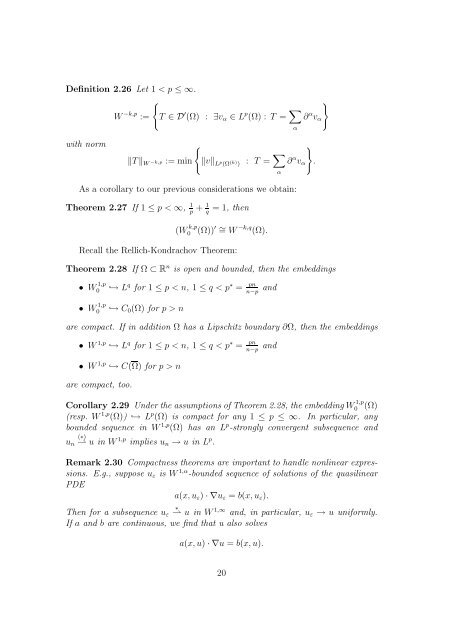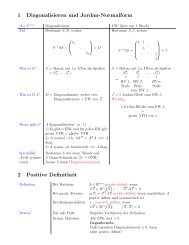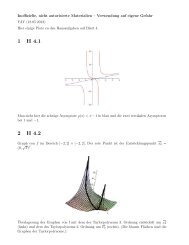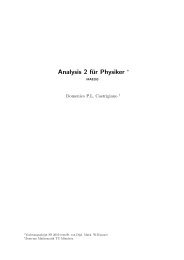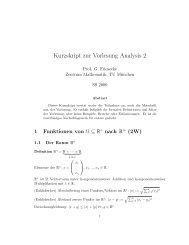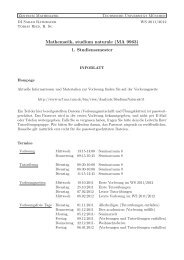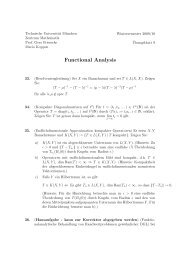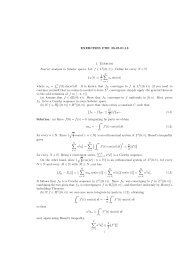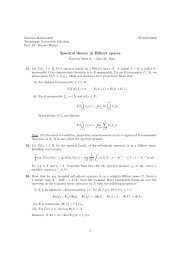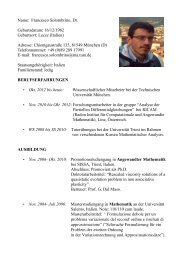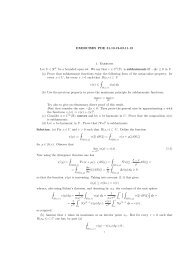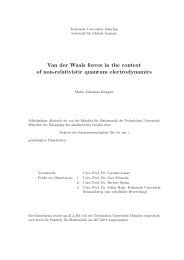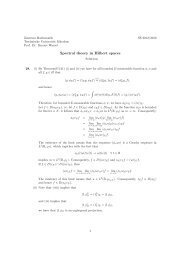Weak Convergence Methods for Nonlinear Partial Differential ...
Weak Convergence Methods for Nonlinear Partial Differential ...
Weak Convergence Methods for Nonlinear Partial Differential ...
Erfolgreiche ePaper selbst erstellen
Machen Sie aus Ihren PDF Publikationen ein blätterbares Flipbook mit unserer einzigartigen Google optimierten e-Paper Software.
Definition 2.26 Let 1 < p ≤ ∞.<br />
{<br />
W −k,p := T ∈ D ′ (Ω) : ∃v α ∈ L p (Ω) : T = ∑ α<br />
∂ α v α<br />
}<br />
with norm<br />
‖T ‖ W −k,p := min<br />
{<br />
‖v‖ L p (Ω (k) ) : T = ∑ α<br />
∂ α v α<br />
}.<br />
As a corollary to our previous considerations we obtain:<br />
Theorem 2.27 If 1 ≤ p < ∞, 1 p + 1 q<br />
= 1, then<br />
(W k,p<br />
0 (Ω)) ′ ∼ = W −k,q (Ω).<br />
Recall the Rellich-Kondrachov Theorem:<br />
Theorem 2.28 If Ω ⊂ R n is open and bounded, then the embeddings<br />
• W 1,p<br />
0 ֒→ L q <strong>for</strong> 1 ≤ p < n, 1 ≤ q < p ∗ = pn<br />
n−p and<br />
• W 1,p<br />
0 ֒→ C 0 (Ω) <strong>for</strong> p > n<br />
are compact. If in addition Ω has a Lipschitz boundary ∂Ω, then the embeddings<br />
• W 1,p ֒→ L q <strong>for</strong> 1 ≤ p < n, 1 ≤ q < p ∗ = pn<br />
n−p and<br />
• W 1,p ֒→ C(Ω) <strong>for</strong> p > n<br />
are compact, too.<br />
Corollary 2.29 Under the assumptions of Theorem 2.28, the embedding W 1,p<br />
0 (Ω)<br />
(resp. W 1,p (Ω)) ֒→ L p (Ω) is compact <strong>for</strong> any 1 ≤ p ≤ ∞. In particular, any<br />
bounded sequence in W 1,p (Ω) has an L p -strongly convergent subsequence and<br />
(∗)<br />
u n ⇀ u in W 1,p implies u n → u in L p .<br />
Remark 2.30 Compactness theorems are important to handle nonlinear expressions.<br />
E.g., suppose u ε is W 1,α -bounded sequence of solutions of the quasilinear<br />
PDE<br />
a(x, u ε ) · ∇u ε = b(x, u ε ).<br />
Then <strong>for</strong> a subsequence u ∗ ε ⇀ u in W 1,∞ and, in particular, u ε → u uni<strong>for</strong>mly.<br />
If a and b are continuous, we find that u also solves<br />
a(x, u) · ∇u = b(x, u).<br />
20


